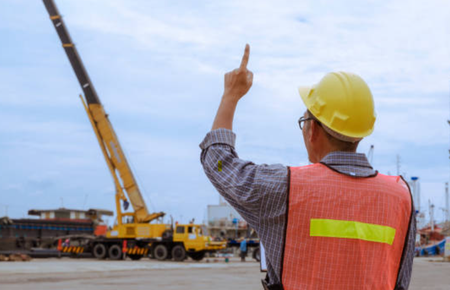
Popular Crane Hand Signals and What They Mean
To ensure safety and efficiency on construction sites, crane operators and other personnel use standardized hand signals to communicate. This is to prevent any OSHA Violations. Here’s a properly ordered and detailed guide to these essential crane hand signals:
Stop:
Signal: Extend one arm horizontally to the side, palm down, and hold the position steadily.
Purpose: Indicates an immediate stop of the crane’s current motion.
Emergency Stop:
Signal: Extend arms horizontally, palms down, and wave them rapidly back and forth.
Purpose: Signals an urgent stop of all crane operations, typically in response to a potential or actual hazard.
Hoist:
Signal: Extend one arm vertically upward, palm forward, fingers closed.
Purpose: To signal the crane to hoist or lift the load.
Lower:
Signal: Extend one arm downward, palm facing down, and move the hand in a small vertical circle.
Purpose: To direct the crane to lower the load.
Raise Boom:
Signal: Bend the elbow with the forearm vertical, fingers closed and thumb pointing upward.
Purpose: Directs the crane to raise its boom.
Lower Boom:
Signal: Bend the elbow with the forearm vertical, fingers closed and thumb pointing downward.
Purpose: Directs the crane to lower its boom.
To know more about crane booms, click here.
Swing:
Signal: Extend one arm horizontally to the side, palm down, and point with the index finger in the direction the boom should swing.
Purpose: Indicates the direction in which the crane’s boom should swing.
Trolley Travel Out (Extend):
Signal: Extend one arm forward, palm up, and make a pushing motion in the direction of desired trolley movement.
Purpose: Directs the crane to move the trolley away from the operator.
Trolley Travel In (Retract):
Signal: Extend one arm forward, palm down, and make a pulling motion towards the body.
Purpose: Directs the crane to move the trolley towards the operator.
Dog Everything (Stop All Motions):
Signal: Cross both arms over the chest with fists clenched.
Purpose: A universal signal to cease all crane movements immediately.
Travel (for mobile cranes):
Signal: Bend both arms at the elbows, fists closed, with thumbs pointing in the direction of travel.
Purpose: Signals the crane to move forward or backward.
Multiple Trolleys:
Signal: Use one hand to show the number of the trolley (one finger for trolley 1, two fingers for trolley 2), followed by standard trolley signals.
Purpose: To specify which trolley should be moved when a crane has multiple trolleys.
Use Main Hoist:
Signal: Tap the top of the head with one hand and then proceed with the desired action signals.
Purpose: Specifies that the main hoist should be used for the next operations.
Use Whip Line (Auxiliary Hoist):
Signal: Tap the elbow with one hand and then proceed with the desired action signals.
Purpose: Specifies that the auxiliary hoist should be used for the next operations.
Importance of Crane Hand Signals
Crane operations are integral to construction sites, but they come with inherent risks. Effective communication between crane operators and ground personnel is crucial for ensuring safety. Crane hand signals serve as a standardized method of communication, enabling clear and immediate instructions even in noisy or visually obstructed environments. Understanding and utilizing these signals promote jobsite safety by facilitating precise movements of heavy loads, preventing accidents, and minimizing the risk of injury. From signaling hoists and swings to emergency stops, each hand gesture plays a vital role in coordinating crane operations. By promoting the widespread adoption and consistent application of crane hand signals, construction teams can enhance safety protocols and create a safer working environment for all personnel involved. To know more about cranes, click here.